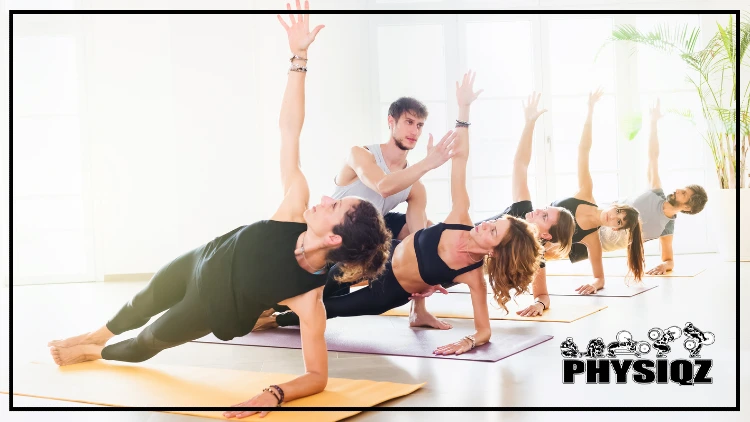
Wall walk alternative exercises are great to change up the status-quo and if progress has stalled, these substitutes workouts are even better for toning and overall body recomposition.1
Not to mention, these alternatives will can also improve your ability to do a wall walk but to fully understand why, let’s first review what the wall walk is, how to perform it, and the muscles worked before showing you the wall walk substitutes that work even better.
What Is the Wall Walk? How Do You Perform the Wall Walk?
Before we cover the alternatives, let’s make sure we’re on the same page on what a wall walk is and how to perform it in order to understand why alternatives may work even better.
To put it simply, the wall walk is an exercise used to develop overall athleticism and mobility, as well as improve strength in the upper body and core.
To perform the wall walk, begin by getting into a pushup position with the feet next to a wall. The lifter can begin by stepping their feet up the wall while keeping them close together until the hips are at full extension.
At this point, the lifter should have ‘walked’ their feet all the way up the wall until they are basically in a handstand position but have their feet on the wall in order to take a bit of weight off of the body, making sure to harden muscles in the shoulder and core for stability.
One point to note is that for athletes, the wall walk is a great movement to build up to the handstand and other upside-down movements. It can be performed and trained gradually by slowly stepping the feet up the wall and holding an isometric contraction at sticking points throughout the entire movement.
That being said, the wall walk isn’t a great exercise to get toned or jacked, so let’s take a look at the muscles worked in the wall walk so we can find substitutes that work the same muscle groups.
What Muscles Do Wall Walks & Suitable Wall Walk Substitutes Work?
Wall walks and their alternatives technically activate the vast majority of the entire body’s musculature, as it requires both the upper body to be pushed up off of the ground and for the legs to be contracted as they walk up the wall.
This means that essentially every muscle group, except the back, is being ‘used’ throughout the wall walk and even the back is doing some stabilization.
However, while the wall walk does use a lot of muscle groups, there are three main areas that wall walks and it’s alternatives specifically target and cause shear stress upon: the shoulders, the core, and the triceps.
The Shoulders (All Three Heads of The Deltoid: Anterior, Lateral & Posterior)
Wall walks work the front, back, and side muscles of the shoulder.
The anterior deltoids, or front of the shoulder, are the major prime movers responsible for pushing away from the floor and picking up the majority of the activation in the shoulders. After performing the wall walk, expect to have fatigued front delts.
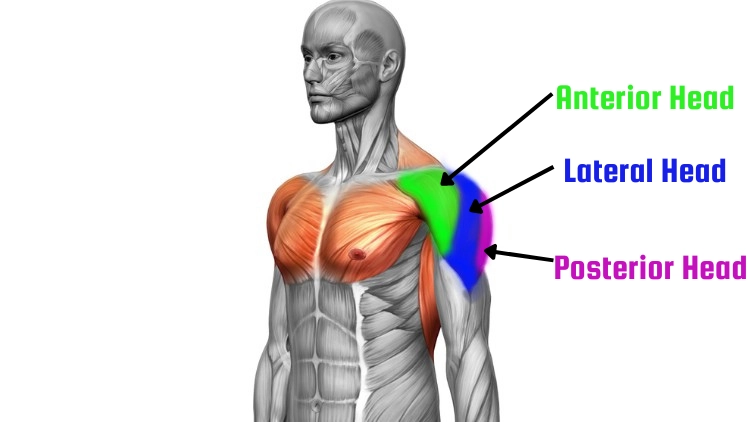
Source: Science Photo Library via Canva.com2
The lateral and posterior deltoids, also known as the side and rear delts, provide stabilization throughout the concentric and eccentric portions of the any handstand-like movement but are primarily used to keep the arms stable all throughout.
This is where the rear delts come into play; without strong rear delts, the wall walk and it’s substitutes itself will be a very difficult movement, because the shoulder will not be stabilized from the front and back to stay in a safe position.
The Core & Abdominal Muscles
In the wall walk and all the alternatives below, the core muscles are essentially the foundation. The abdominals, obliques, and spinal erectors provide stability throughout each movement, ensuring that the spine is protected throughout the movement.
The tension placed on the core is similar to that placed on the body through a plank, but at a greater level: it forces the abs to be contracted isometrically, but because there is more weight being leveraged against the body, they have to work harder than in a plank.
The Triceps & The Rotator Cuff (Stabilize The Arm)
The wall walk and any decent alternative will also work the triceps and rotator cuff muscles. This is important because these muscle groups help to stabilize the arm as it is pushing away from the wall or ground in some of the substitutes.
The triceps help to push off of the wall or ground, and the rotator cuff helps to keep the shoulder joint stable throughout as it is being pressed against the wall.
Why Should Alternatives to the Wall Walk Be Considered? Is The Wall Walk Effective For Hypertrophy & Strength?
Overall, the wall walk has very specific use cases and is an effective exercise for hypertrophy and strength gains.
While it does load a lot of weight onto the upper body musculature that many exercises cannot do, it doesn’t actually take many muscles through a range of motion that will cause much muscle damage, which is a key part of hypertrophy.3
Think about it this way: if a muscle is not taken through its full range of motion through a combination of exercises, it cannot be grown to its fullest potential. In addition, the wall walk can not be loaded in an easy or safe manner so progressive overload is not possible — and this is needed to grow any muscle.
An isometric contraction (bracing a muscle) can only provide so much of a stimulus for various muscle groups in general, but isometrics can be beneficial to add on as an afterthought of sorts, used to finish burning out different muscle groups in the body.
Regardless, the wall walk is great for athleticism and mobility, as it forces the athlete’s body into a mechanically difficult position with gravity bearing down on their entire upper body, as well as forcing the core and spine to be tight to prevent injury.
Due to this fact, it is great for those who are looking to prioritize mobility and general athleticism as it is one of the few movements that forces the entire body to be stabilized in an isometric, upside-down position.
Many alternatives to wall walks offer superior hypertrophy and strength gains compared to wall walks for individuals seeking muscle building or toning.
The Best Wall Walk Alternatives (For Hypertrophy & Strength)
In theory, push ups and sit ups together could stimulate the triceps and core to some extent, but they are not the optimal exercises to do so.
Let’s begin the list of effective exercises that can substitute for wall walks by discussing the shoulders first, as they constitute the largest muscle group and thus necessitate greater volume compared to both the core and triceps.
Alternatives That Work the Shoulders & Rotator Cuff
Since the wall walk works a variety of shoulder muscles, a variety of exercises is required but again, these will provide better results overall.
Overhead Presses
Overhead presses are one of the most effective shoulder-building exercises in existence, even for those who believe they have bad shoulder genetics. To perform the overhead press (OHP), begin by sitting or standing with a weight in each hand (barbell, dumbbells, kettlebells, etc.).
Bring the weights to shoulder level with palms facing forward and elbows bent. From here, press the weights overhead until the arms are straight.
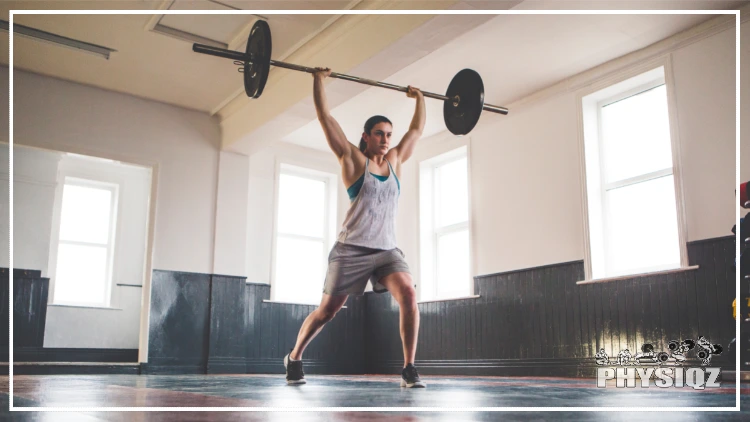
Source: SolStock via Canva.com4
Be sure to keep the core engaged and back pressed firmly against the bench or wall for support. This will ensure that the vast majority of the weight is being loaded onto the shoulder muscles; overall, the OHP will prioritize the growth of the lateral and front deltoid, with the rear delt being used to some extent as a stabilizer.5
Pike Pushups
The pike pushup is another great shoulder exercise that can be performed as an alternative to the wall walk. This exercise targets the anterior deltoids and the triceps muscles. To perform the pike pushup, begin in a plank position with feet together and hands shoulder-width apart.
The lifter should then walk their feet closer to their hands to form an upside-down V with their body. From here, slowly lower toward the ground while keeping hips elevated, bending at the elbow.
The path which the elbow follows when bending is similar to the Egyptian pushup, meaning the elbows should not flare out to the sides. Flaring the elbows out leaves the athlete at a greater risk for injury because it puts the shoulder in a more disadvantageous position.
Regardless, from here, press back up to the starting position and repeat, focusing on pushing through the shoulder and keeping tension on it throughout the movement.
Bear Crawls
Finally, bear crawls are a great triceps exercise that can be used as an alternative to wall walks. To perform bear crawls, start on all fours with hands directly below shoulders and knees beneath hips; the starting position is the same as the pike pushup.
The difference comes in the motion; rather than bending at the elbow, step forward with the left foot, then reach forward with the right hand; then, alternate.
The objective is to crawl a set distance while prioritizing pushing through the shoulders. A good cue to think of for this exercise is to imagine falling forward; for many lifters, this helps to make it feel as if their shoulders are being activated significantly better.
The bear crawl provides an effective alternative to the wall walk by engaging the upper body to stabilize the shoulders through isometric contraction. However, it’s notably less challenging than the wall walk since it doesn’t involve elevating the feet onto a wall.
This means that while a variable level of stress can be placed on the shoulders by changing foot positioning and where the weight is shifted, the bear crawl is a lot less intensive on the joints than the wall walk; it can almost be considered to be a beginner wall walk.
All three exercises will increase strength and hypertrophy of the deltoids without having to worry about form breakdowns due to the high intensity of the wall walk.
The overhead press helps build strength and size in the shoulders, while the pike pushup will help target the anterior deltoids and triceps muscles. Bear crawls are great for developing explosive power as well as strengthening all muscle groups involved in crawling (shoulders, arms, core, and legs).
The face pull can also be added on top of any beginner hypertrophy program that uses any of these movements to help train the rear deltoids to be stronger, but with all of these exercises, it is important to keep good form and avoid any type of strain or injury.
DB External Rotation
Lastly, the dumbbell external rotation is great for targeting the rotator cuff muscles. To perform this exercise, grab one dumbbell with light weight and sit down on the ground. Place one foot on the ground to raise the knee up, and let the other leg lie in a comfortable position.
For whichever knee is raised, place that side’s respective elbow on the knee with the dumbbell in hand. Let the dumbbell slowly fall toward the ground to set up for the start of the movement.
This movement should be performed at a very controlled pace with a very light weight because heavy weights and improper form can easily lead to injury of the rotator cuff.
This is a great exercise for targeting the rotator cuff and makes for an easy addition to any core or shoulder routine. Luckily, research shows that performing rotator cuff training even once per week can provide a good base of strength to grow from.
Substitutes That Work the Core
The core is another muscle group that is extremely important for overall athleticism and strength.
Hanging Leg Raises
Hanging leg raises are an effective exercise to target the abdominal muscles and obliques. To perform a hanging leg raise, begin by hanging from a pull-up bar with feet together and palms facing forward.
From here, lift the legs up towards the chest as high as possible and lower them back down in a slow and controlled manner.
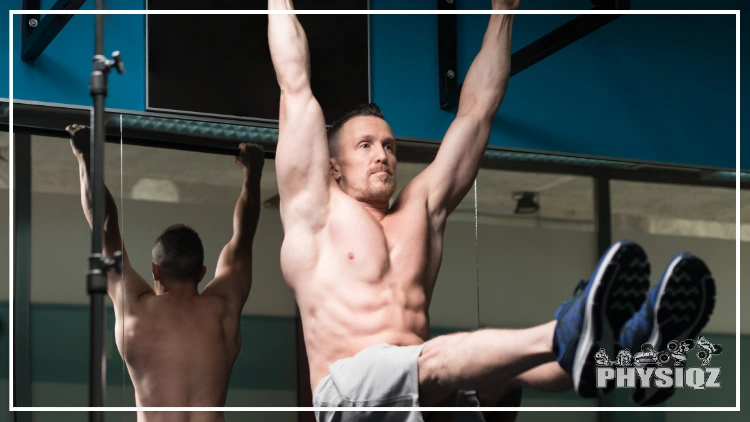
Source: Ibrakovic via Canva.com6
It is important to keep the core tight throughout the exercise and focus on using the abs, not the hip flexors, to bring the legs up.
Side Planks
Side planks offer an effective means to engage the obliques and hip abductors, serving as an excellent substitute for wall walks.
To perform this exercise, begin by lying on one side with the feet stacked on top of each other (or have the top foot in front of the other in a heel-toe position); the arms should be bent at a 90-degree angle and placed directly below the shoulders.
From here, lift the hips off the ground until the body is in a straight line from head to feet, and hold this position for a set time.
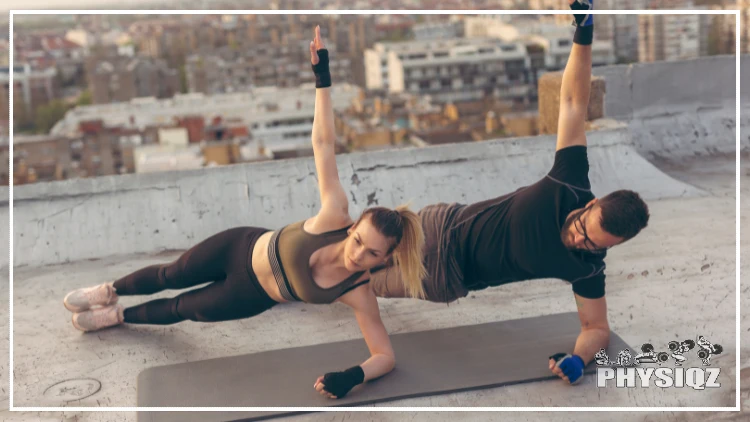
Source: vladans via Canva.com7
This exercise should be performed on both sides in order to ensure an even strength and development of both sides.
People who perform the movement properly should feel a lot of tension along the oblique, or the side of the abs, which is the priority; this will help to develop rotational stability in the body, as the obliques are the main muscle that develops this mechanism.8
Overall, hanging leg raises and side planks are great exercises for targeting the core and helping to build a strong and well-rounded athlete.
As with any exercise, it is important to focus on proper form and technique to maximize the exercise’s effectiveness; in doing so, overcoming bad ab genetics is very possible.
Wall Walk Alternative or Replacement Exercises for the Triceps
Since the wall walk has you pushing through the ground but with no load, these exercise are superior since you can add weight once your go-to weight becomes easier.
Skullcrushers
Skullcrushers are an effective exercise for targeting the triceps. To perform this movement, begin by lying on a flat bench with a set of dumbbells in each hand.
From here, extend the arms straight up towards the sky and then slowly lower them down behind the head.
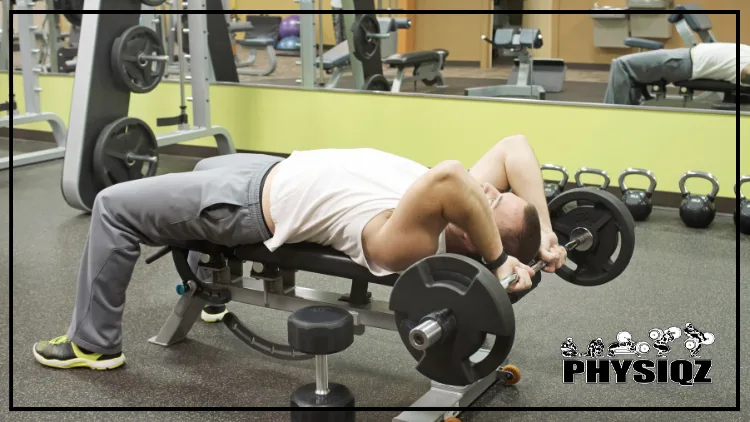
Source: lawcain via Canva.com9
To make this movement harder and to target the long head of the triceps more, ‘drag’ the elbows towards the head, meaning the elbows are no longer directly aligned above the shoulder.
This will automatically place the triceps in a more stretched position and target the triceps similarly to the wall walk.
This is because in the wall walk since the arms are completely extended and straightened while upside down, the long head of the triceps is being held in an isometric contraction, so skull crushers with an extra stretch added are perfect to train the long head of the triceps.
Diamond Pushups
For the diamond pushup, begin by getting into a pushup position with the hands placed close together to form a diamond.
From here, lower the body down toward the ground and press back up. This exercise will target both the triceps and the chest, as it is a great combination of both a pushup and triceps extension, but it is not the same as a bench press.

Source: Wavebreakmedia via Canva.com10
But, because of where the hands are placed, the triceps take on a significant amount of the weight throughout the movement; most people who perform the diamond pushup notice that they can feel their triceps contracting significantly ‘harder’ than in the traditional pushup.
Performing the diamond pushup will even garner a triceps contraction similar to that from the dip, which is impressive since it is just a bodyweight movement.11 For those curious about the muscle groups targeted by dips, they primarily engage the lower pecs, the long head of the triceps, and also provide a slight shoulder stretch.
Make sure to keep in mind the earlier form information mentioned about the pike pushup – bending the elbows and ‘floating’ the chest forward, rather than flaring the elbows out, will keep the shoulder in a much safer position and offer a better overall contraction for the long head of the triceps.
Now, ensuring that the wrist is straight and aligned with the forearm, cue the movement by pulling the weight up, imagining the shoulder rotating is causing the dumbbell to be raised.
In conclusion, skull crushers and diamond pushups are great movements to target the long head of the triceps, similar to what is contracted during the wall walk, and the dumbbell external rotation is great for developing better strength and mobility in the rotator cuff.
Without strengthening these two separate areas, developing a similar strength profile to that achieved from the wall walk would be difficult.
Overall, there are many wall walk substitute exercises that can train similar muscles, but they must be used in tandem in order to garner a similar stimulus to the wall walk itself.
That being said, the wall walk is primarily an athletic movement used in niche situations, so these wall walk alternative exercises will ultimately be better for long-term hypertrophy and strength goals.
References
1photology2000. Canva. Accessed 19 April 2023. <https://www.canva.com/photos/MAEOxgTZsMg-yoga-class-doing-side-plank-with-trainer/>
2Science Photo Library. Canva. Accessed 19 April 2023. <https://www.canva.com/photos/MADmTGwAFbo-the-muscles-involved-in-standing-biceps-curl-the-stabilizing-muscles-are-highlighted-/>
3Schoenfeld, B. (2012). Does exercise-induced muscle damage play a role in skeletal muscle hypertrophy? Journal of Strength and Conditioning Research, 26(5), 1441-53. <https://pubmed.ncbi.nlm.nih.gov/22344059/>
4SolStock. Canva. Accessed 19 April 2023. <https://www.canva.com/photos/MAEJKaSphrY-professional-female-powerlifter-doing-overhead-press/>
5Campos, Y., Vianna, J., Guimaraes, M., Oliviera, J., Hernandez-Mosqueira, C., da Silva, S., & Marchetti, P. (2020). Different Shoulder Exercises Affect the Activation of Deltoid Portions in Resistance-Trained Individuals. Journal of Human Kinetics, 75, 5-14. <https://www.ncbi.nlm.nih.gov/pmc/articles/PMC7706677/>
6Ibrakovic. Canva. Accessed 19 April 2023. <https://www.canva.com/photos/MAEDKGysbas-athlete-performing-hanging-leg-raises-exercise/>
7vladans. Canva. Accessed 19 April 2023. <https://www.canva.com/photos/MADZ__UEtUg-side-plank-exercise/>
8Ng, J., Parnianpour, M., Richardson, C., & Kippers, V. (2001). Functional roles of abdominal and back muscles during isometric axial rotation of the trunk. Journal of Orthopedic Research, 19(3), 463-71. <https://pubmed.ncbi.nlm.nih.gov/11398861/>
9lawcain. Canva. Accessed 19 April 2023. <https://www.canva.com/photos/MADBLBUZJ6Y-man-doing-e-z-curl-bar-skullcrusher/>
10Wavebreakmedia. Canva. Accessed 19 April 2023. <https://www.canva.com/photos/MADFeU27-rY-man-doing-diamond-push-ups/>
11Bagchi, A. (2015). A Comparative Electromyographical Investigation of Triceps Brachii and Pectoralis Major During Four Different Freehand Exercises. Journal of Physical Education Research, 2(2), 20-27. <https://www.academia.edu/69334604/A_Comparative_Electromyographical_Investigatio>